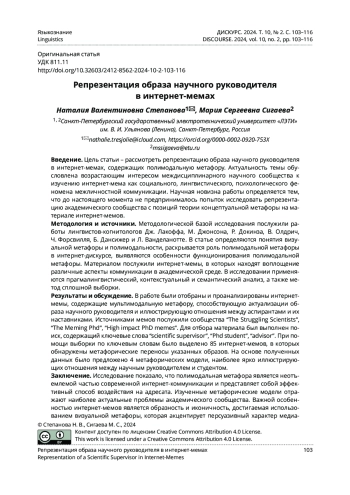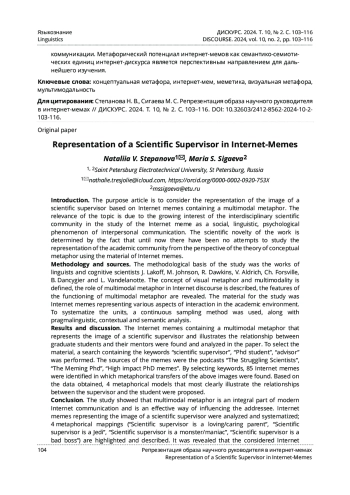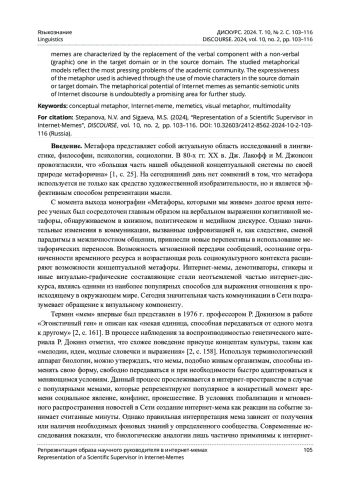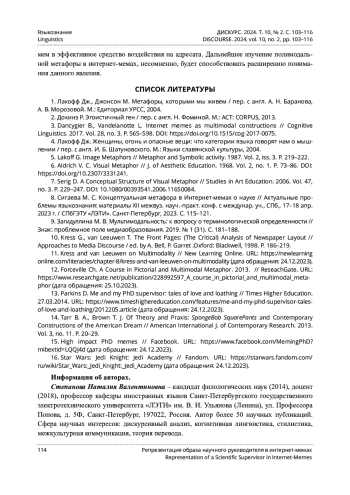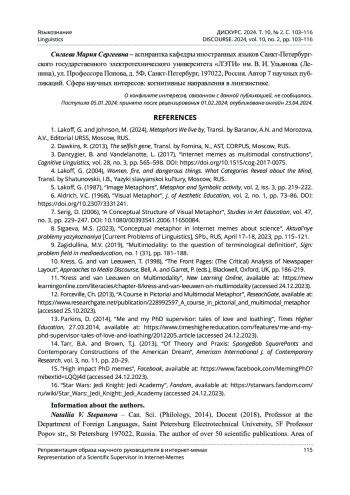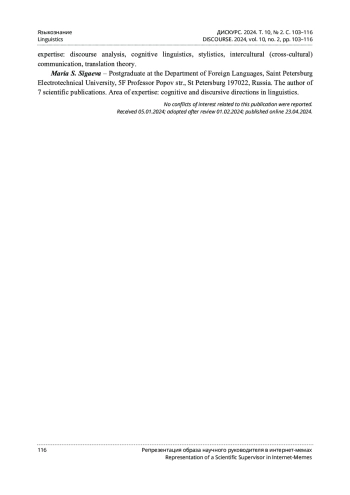Введение. Цель статьи - рассмотреть репрезентацию образа научного руководителя в интернет-мемах, содержащих полимодальную метафору. Актуальность темы обусловлена возрастающим интересом междисциплинарного научного сообщества к изучению интернет-мема как социального, лингвистического, психологического феномена межличностной коммуникации. Научная новизна работы определяется тем, что до настоящего момента не предпринималось попыток исследовать репрезентацию академического сообщества с позиций теории концептуальной метафоры на материале интернет-мемов. Методология и источники. Методологической базой исследования послужили работы лингвистов-когнитологов Дж. Лакоффа, М. Джонсона, Р. Докинза, В. Олдрич, Ч. Форсвилля, Б. Дансижер и Л. Ванделанотте. В статье определяются понятия визуальной метафоры и полимодальности, раскрывается роль полимодальной метафоры в интернет-дискурсе, выявляются особенности функционирования полимодальной метафоры. Материалом послужили интернет-мемы, в которых находят воплощение различные аспекты коммуникации в академической среде. В исследовании применяются прагмалингвистический, контекстуальный и семантический анализ, а также метод сплошной выборки. Результаты и обсуждение. В работе были отобраны и проанализированы интернетмемы, содержащие мультимодальную метафору, способствующую актуализации образа научного руководителя и иллюстрирующую отношения между аспирантами и их наставниками. Источниками мемов послужили сообщества “The Struggling Scientists”, “The Meming Phd”, “High impact PhD memes”. Для отбора материала был выполнен поиск, содержащий ключевые слова “scientific supervisor”, “Phd student”, “advisor”. При помощи выборки по ключевым словам было выделено 85 интернет-мемов, в которых обнаружены метафорические переносы указанных образов. На основе полученных данных было предложено 4 метафорических модели, наиболее ярко иллюстрирующих отношения между научным руководителем и студентом.
Заключение. Исследование показало, что полимодальная метафора является неотъемлемой частью современной интернет-коммуникации и представляет собой эффективный способ воздействия на адресата. Изученные метафорические модели отражают наиболее актуальные проблемы академического сообщества. Важной особенностью интернет-мемов является образность и иконичность, достигаемая использованием визуальной метафоры, которая акцентирует персуазивный характер медиа-коммуникации. Метафорический потенциал интернет-мемов как семантико-семиотических единиц интернет-дискурса является перспективным направлением для дальнейшего изучения.
Introduction. The purpose article is to consider the representation of the image of a scientific supervisor based on Internet memes containing a multimodal metaphor. The relevance of the topic is due to the growing interest of the interdisciplinary scientific community in the study of the Internet meme as a social, linguistic, psychological phenomenon of interpersonal communication. The scientific novelty of the work is determined by the fact that until now there have been no attempts to study the representation of the academic community from the perspective of the theory of conceptual metaphor using the material of Internet memes. Methodology and sources. The methodological basis of the study was the works of linguists and cognitive scientists J. Lakoff, M. Johnson, R. Dawkins, V. Aldrich, Ch. Forsville, B. Dancygier and L. Vandelanotte. The concept of visual metaphor and multimodality is defined, the role of multimodal metaphor in Internet discourse is described, the features of the functioning of multimodal metaphor are revealed. The material for the study was Internet memes representing various aspects of interaction in the academic environment. To systematize the units, a continuous sampling method was used, along with pragmalinguistic, contextual and semantic analysis. Results and discussion. The Internet memes containing a multimodal metaphor that represents the image of a scientific supervisor and illustrates the relationship between graduate students and their mentors were found and analyzed in the paper. To select the material, a search containing the keywords “scientific supervisor”, “Phd student”, “advisor” was performed. The sources of the memes were the podcasts “The Struggling Scientists”, “The Meming Phd”, “High impact PhD memes”. By selecting keywords, 85 Internet memes were identified in which metaphorical transfers of the above images were found. Based on the data obtained, 4 metaphorical models that most clearly illustrate the relationships between the supervisor and the student were proposed. Conclusion. The study showed that multimodal metaphor is an integral part of modern Internet communication and is an effective way of influencing the addressee. Internet memes representing the image of a scientific supervisor were analyzed and systematized; 4 metaphorical mappings (“Scientific supervisor is a loving/caring parent”, “Scientific supervisor is a Jedi”, “Scientific supervisor is a monster/maniac”, “Scientific supervisor is a bad boss”) are highlighted and described. It was revealed that the considered Internet memes are characterized by the replacement of the verbal component with a non-verbal (graphic) one in the target domain or in the source domain. The studied metaphorical models reflect the most pressing problems of the academic community. The expressiveness of the metaphor used is achieved through the use of movie characters in the source domain or target domain. The metaphorical potential of Internet memes as semantic-semiotic units of Internet discourse is undoubtedly a promising area for further study.

